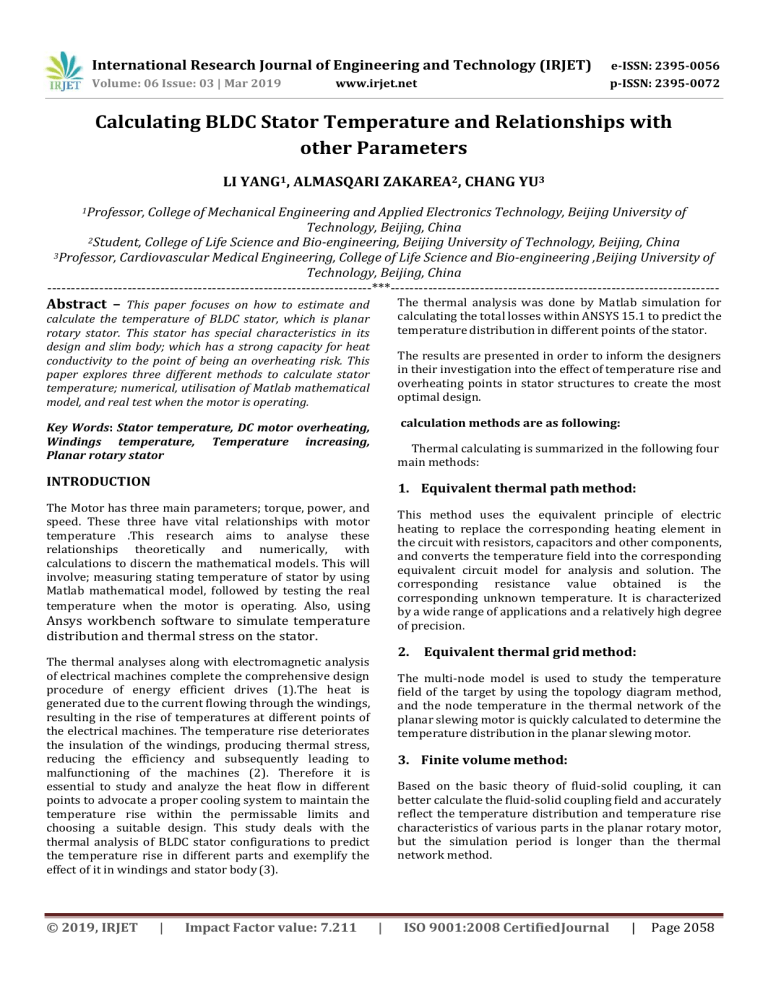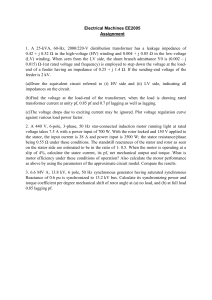IRJET- Calculating BLDC Stator Temperature and Relationships with Other Parameters
advertisement

International Research Journal of Engineering and Technology (IRJET) e-ISSN: 2395-0056 Volume: 06 Issue: 03 | Mar 2019 p-ISSN: 2395-0072 www.irjet.net Calculating BLDC Stator Temperature and Relationships with other Parameters LI YANG1, ALMASQARI ZAKAREA2, CHANG YU3 1Professor, College of Mechanical Engineering and Applied Electronics Technology, Beijing University of Technology, Beijing, China 2Student, College of Life Science and Bio-engineering, Beijing University of Technology, Beijing, China 3Professor, Cardiovascular Medical Engineering, College of Life Science and Bio-engineering ,Beijing University of Technology, Beijing, China ---------------------------------------------------------------------***---------------------------------------------------------------------- Abstract – This paper focuses on how to estimate and The thermal analysis was done by Matlab simulation for calculating the total losses within ANSYS 15.1 to predict the temperature distribution in different points of the stator. calculate the temperature of BLDC stator, which is planar rotary stator. This stator has special characteristics in its design and slim body; which has a strong capacity for heat conductivity to the point of being an overheating risk. This paper explores three different methods to calculate stator temperature; numerical, utilisation of Matlab mathematical model, and real test when the motor is operating. The results are presented in order to inform the designers in their investigation into the effect of temperature rise and overheating points in stator structures to create the most optimal design. calculation methods are as following: Key Words: Stator temperature, DC motor overheating, Windings temperature, Temperature increasing, Planar rotary stator Thermal calculating is summarized in the following four main methods: INTRODUCTION 1. Equivalent thermal path method: The Motor has three main parameters; torque, power, and speed. These three have vital relationships with motor temperature .This research aims to analyse these relationships theoretically and numerically, with calculations to discern the mathematical models. This will involve; measuring stating temperature of stator by using Matlab mathematical model, followed by testing the real temperature when the motor is operating. Also, using This method uses the equivalent principle of electric heating to replace the corresponding heating element in the circuit with resistors, capacitors and other components, and converts the temperature field into the corresponding equivalent circuit model for analysis and solution. The corresponding resistance value obtained is the corresponding unknown temperature. It is characterized by a wide range of applications and a relatively high degree of precision. Ansys workbench software to simulate temperature distribution and thermal stress on the stator. 2. The thermal analyses along with electromagnetic analysis of electrical machines complete the comprehensive design procedure of energy efficient drives (1).The heat is generated due to the current flowing through the windings, resulting in the rise of temperatures at different points of the electrical machines. The temperature rise deteriorates the insulation of the windings, producing thermal stress, reducing the efficiency and subsequently leading to malfunctioning of the machines (2). Therefore it is essential to study and analyze the heat flow in different points to advocate a proper cooling system to maintain the temperature rise within the permissable limits and choosing a suitable design. This study deals with the thermal analysis of BLDC stator configurations to predict the temperature rise in different parts and exemplify the effect of it in windings and stator body (3). © 2019, IRJET | Impact Factor value: 7.211 Equivalent thermal grid method: The multi-node model is used to study the temperature field of the target by using the topology diagram method, and the node temperature in the thermal network of the planar slewing motor is quickly calculated to determine the temperature distribution in the planar slewing motor. 3. Finite volume method: Based on the basic theory of fluid-solid coupling, it can better calculate the fluid-solid coupling field and accurately reflect the temperature distribution and temperature rise characteristics of various parts in the planar rotary motor, but the simulation period is longer than the thermal network method. | ISO 9001:2008 Certified Journal | Page 2058 International Research Journal of Engineering and Technology (IRJET) e-ISSN: 2395-0056 Volume: 06 Issue: 03 | Mar 2019 p-ISSN: 2395-0072 www.irjet.net 4. Finite element method: Then, the heat conduction boundary condition, the convective heat transfer boundary condition and the heat generation rate of the heat source are obtained by the formula, and the above formula is brought into the equation, and the calculation result of the temperature field of the plane rotary motor is finally obtained. The temperature field of the stator winding turns can be calculated more accurately, and the temperature of each part in the stator can be obtained, which can explain the influence of various factors in the winding turns on the temperature of the planar rotary motor. However, the calculation of fluid and solid coupling fields in liquid-cooled planar rotary motors is not sufficient. (2) Thermal grid mathematical model: When calculating the temperature field of a planar stator using the thermal network method and the finite volume method, it is necessary to consider the end face heat transfer and internal heat transfer of each component in the planar rotary motor. The calculation of heat transfer coefficient and heat transfer coefficient in the plane rotary motor directly affects the accuracy of the temperature field calculation of the planar rotary motor. Therefore, for each part of the planar rotary motor, the heat transfer coefficient and the heat transfer coefficient are processed one by one. After the equivalent processing, the model of the planar rotary motor is formed. (1) Heat transfer calculation model for temperature field of winding turns: In order to make the heat transfer inside the planar rotary motor more efficient, the heat transfer process in the planar rotary motor is now expressed in the form of equations. When working with a permanent magnet synchronous planar rotary motor, the internal heat transfer process can be simplified to the following equation: 2T s x 2 c T According to the basic structure of the planar rotary motor, the heat transfer is divided into flat wall heat transfer and cylindrical wall heat transfer during the heat dissipation process, and the corresponding thermal resistance is calculated according to the following formula: T S1 0 n s T S 2 (T Te ) Rp n A 1 Equation 1 R In(r1 / r2 ) 2 & Equation 2 Where: T—planar rotary motor temperature (°C); Where: Rp is the heat transfer resistance of the flat wall; Ρ—density of material (kg/m3); Rc is the heat transfer resistance of the cylinder wall; C—specific heat capacity of the material (J/(kg·m3)); δ flat wall heat transfer thickness; τ —time variable (s); λ is the heat transfer coefficient of the object; S1—the adiabatic boundary surface of stator; A1 is the flat wall heat transfer area; S2—the thermal boundary surface of the stator; r1, r2 is the circle the outer diameter and inner diameter of the cylinder; l is the length of the cylinder wall. T—the temperature of the ambient medium around the S (°C); During the heat dissipation process of the planar rotary stator, the convective heat transfer thermal resistance is calculated as follows: α—S surface heat dissipation coefficient (W/(m2·°C)); λs—S and S surface method guide heat coefficient (W/(m·°C)); R λ —the average thermal conductivity of the components of the planar rotary motor (W / (m · ° C)); Equation 3 h 1 A Where: Rh is the convective heat transfer resistance; h is the convective heat transfer coefficient; A2 is the convective heat transfer area. After calculating the thermal © 2019, IRJET | Impact Factor value: 7.211 | ISO 9001:2008 Certified Journal | Page 2059 International Research Journal of Engineering and Technology (IRJET) e-ISSN: 2395-0056 Volume: 06 Issue: 03 | Mar 2019 p-ISSN: 2395-0072 www.irjet.net resistance of each part of the planar rotary motor, the steady-state heat balance equations of the planar rotary motor corresponding to the thermal network model are established, as follows: GT W Where: T is the node temperature matrix; W is the heat source loss matrix; G is the thermal conductivity matrix: 1 1 R R 1, j 1, j 1 1 G R2, j R2, j 1 1 Ri,2 Ri,1 1 R1, j 1 R2, j 1 Ri, j Fig -1: Current tracking According to the heat balance equations of the planar rotary motor, the temperature of each node can be calculated by inputting the corresponding parameters. 5. Matlab Mathematical Model Normally the stator has winding to carry the current and create the electromagnetic field around the conductor that interacts with the magnetic material to produce rotation. In the given simulation, the voltage input is applied to the input of motor winding that creates the initial torque required to run the motor. The relationship between the current and motor is describe by first i(t)=1/k*torque. The torque causes the rotation of motor and is related to the angular position of motor. There is no direct relationship between resistance and temperature. However it can be estimated using the following relationship: (T2-T1) = I*I*R*t / (m*c) Fig -2: Rise of temperature Where I is the current m is the mass of material. 6. Measurement Method And c is the specific heat of that material. Practically, we measured the temperature in two points on the stator, on coils windings and stator body by using thermometer. Those two figures shows Matlab simulation of current and temperature. The measurement was completed under two main conditions, first when the power (voltage) is fixed, then after changing the current value from 0.5A to 2A (Chart-1). Second condition current has been adjusted at 1A, then we raised the voltage from 24V to 30V (Chart-2). Results are illustrated in the two following charts: © 2019, IRJET | Impact Factor value: 7.211 | ISO 9001:2008 Certified Journal | Page 2060 International Research Journal of Engineering and Technology (IRJET) e-ISSN: 2395-0056 Volume: 06 Issue: 03 | Mar 2019 p-ISSN: 2395-0072 www.irjet.net Chart -1: 24V /Temperature and Current relationship Fig -4: Temperature distribution in stator body (mesh figure) As shown in figures 3 & 4 the max point heat is on winding turns and less in the main body of stator .We have five steps to analyse the temperature and each step has a mesh figure illustrating the temperature levels at every point on the stator body. 8. CONCLUSIONS During the study of BLDC motor temperature, the three methods of results that we have obtained show that temperature on the stator changes up to many variables, which are resistance, materials, friction fork, BEMF force, and the size and numbers of windings turns. Chart -2: 1A /Temperature and Voltage Relationship At present, there is are variation in the results, with differences between the mathematical calculations and practical experiments, but actually these variances are possibly due to the temperature limitations. There are no specific limits to get the exact temperature value, but it can be estimated. Our stator temperature value goes up to 80 if it is working at max speed in 30 minutes, so as the analyzed results ascertain the causes of overheating and thereby inform how the design needs to be changed. 7. Simulation Using Ansys workbench software to simulate temperature distribution and thermal stress on the stator. Figures 3 & 4 illustrate how the heat is distributed around coils (winding turns) and the whole stator body. ACKNOWLEDGEMENT A special thank goes to my supervisors Prof.CHANG YU, Dr.LI YANG, and all the assistance during my work. I am also very grateful to my two partners from College of Mechanical Engineering and Applied Electronics Technology who made this paper work possible. And I would also like to thank the rest of the staff at BJUT. I would like to thank all the personal Chinese friends for helping me in any way. It has been a pleasure to work here in BJUT. Finally I would like to thank my parents which is the main support for me in my journey in China. Fig -3: Temperature distribution in stator body © 2019, IRJET | Impact Factor value: 7.211 | ISO 9001:2008 Certified Journal | Page 2061 International Research Journal of Engineering and Technology (IRJET) e-ISSN: 2395-0056 Volume: 06 Issue: 03 | Mar 2019 p-ISSN: 2395-0072 www.irjet.net REFERENCES [1] N. R. Namburi and T. H. Barton, "Thermal Modelling of an Induction Motor,", Aug. 1983. [2] David A. Staton, Andrea CavagninoConvection Heat Transfer and Flow Calculations Suitable for Electric Machines Thermal Models, 2008. [3] Anna University ,Thermal Analysis Of The BLDC Motor, 2010. © 2019, IRJET | Impact Factor value: 7.211 | ISO 9001:2008 Certified Journal | Page 2062


